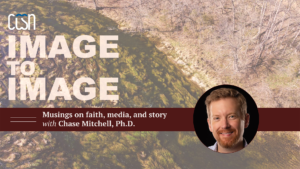Column Description: Image to Image: Musings on Faith, Media, and Story is a monthly column that illuminates old and new ideas about media ecology from a Christian perspective. Dr. Mitchell will explore what it means to bear God’s image and Christian witness in a mediated world, with a particular focus on the relationships between theology, media, and orthopraxy across different Christian traditions.
By Chase Mitchell, Ph.D.
Assistant Professor of Media and Communication, East Tennessee State University
September 2021
Theological Anthropology in Media Studies
I’m grateful that CCSN has invited me to contribute a monthly column, what I’m calling Image to Image, in which I’ll explore what it means to bear God’s image and Christian witness in a mediated world. In this first entry, I introduce theological anthropology—an oft-overlooked field of study that, I suggest, is essential to media studies.
Theological anthropology is the study of the human as she relates to God. Tripartite theology is one anthropological view that Christians have taken down the centuries. It asserts that humankind is a composite of three ontological components: body (soma), soul (psyche), and spirit (pneuma). Proponents of this view, including Martin Luther, have suggested that Second Temple Judaism served typologically to illustrate our triune nature: the outer court referred to the human body; the holy place to the soul; and the holiest of holies to the spirit. Further, some have identified the five pillars between the Temple’s outer court and holy place with the five bodily senses.
When we study media, we refer to things that are perceptible to one or more of the senses: sight, hearing, touch, taste, smell. In doing so, we need to recognize that our understanding of sense perception is fundamentally theological. Although our bodily senses are vital to perception, the ways we interact with and understand the world are not merely sensual. Because tripartite theology claims that the physical body is married to the soul in divine intimacy—sometimes referred to as psychosomatic union—whenever media impress upon the physical senses, the soul is also subject to change. The senses’ role in quickening the body, soul, and spirit is critical to understanding how media function theologically in relation to the New Testament Temple: man/woman.
The tripartite notion of soul is essentially one’s psyche (memories, knowledge, reason, etc.), but not in the Cartesian sense of mind apart from body. Soma and psyche are inextricably linked, and most Christians agree on these terms. However, though tripartite theology was considered an orthodox interpretation through the first three centuries of the church, and it remains a common belief across traditions and denominations, there are nuanced differences regarding pneuma’s nature and operations. Theologians are not entirely in consensus about the existence of a small-s human spirit that is ontologically distinct from the capital-S Holy Spirit. Nor is there universal agreement concerning the relationship between human spirit and Holy Spirit in conversion, justification, sanctification, and/or theosis (depending on the tradition). Those differences have resulted in disparate theological anthropologies, from which have emerged unique manifestations of church media, including the sacraments, liturgies, homiletics, scripture, icons, and now digital media, among others.
Image to Image will be a space for me to explore the differences between Roman Catholic, Eastern Orthodox, and Protestant theological anthropologies by considering their respective media doctrines and practices. I’ll draw extensively on thinkers from the Toronto School, especially, whose approach to media studies has always been somewhat theological. Just as Marshall McLuhan’s Catholicism’s gave rise to his medium-as-message maxim, Jacques Ellul’s Reformed Protestantism shaped his notion of technique. Christian Roy’s work on Eastern Orthodoxy, too, illustrates how theological differences are reflected in religious media. In this column I’ll examine these relationships in more detail, and critique examples of religious media and communication practices in order to show how media and theology are intimately connected.
* Author bio: I teach undergraduate and graduate courses in multimedia production, strategic communication, and media management, and coordinate the Department’s Adobe Certified Associate program. I hold a Ph.D. in Technical Communication & Rhetoric from Texas Tech University and have over a decade of experience in the U.S. and abroad in communication and higher education. I research and write at the intersections of technical communication, digital rhetoric, and multimodal pedagogies. I live in Bristol, Tennessee, with my wife Mott and our two dogs, Bigfoot and Fuzzle. I enjoy baseball, books, and British comedy.

